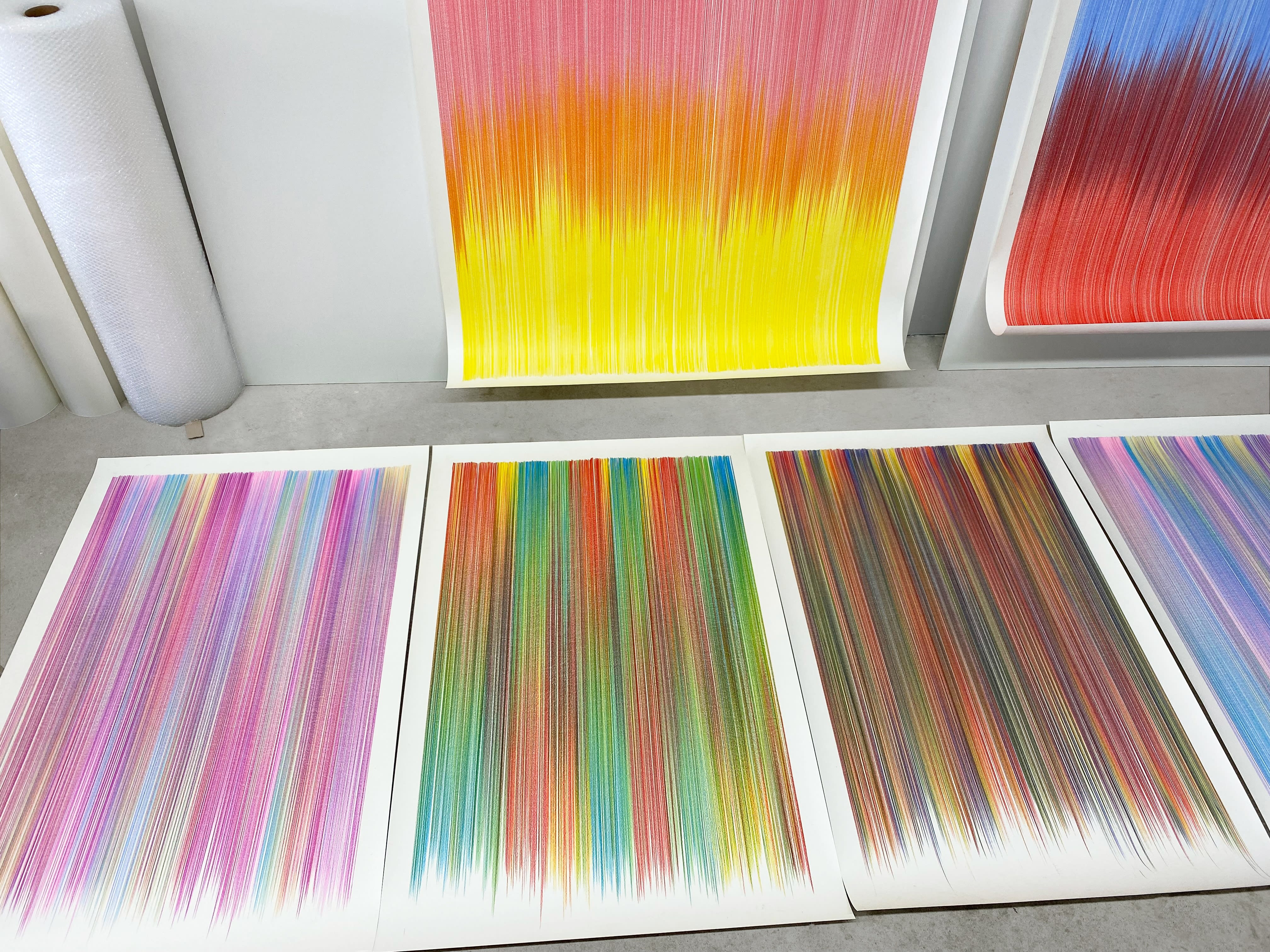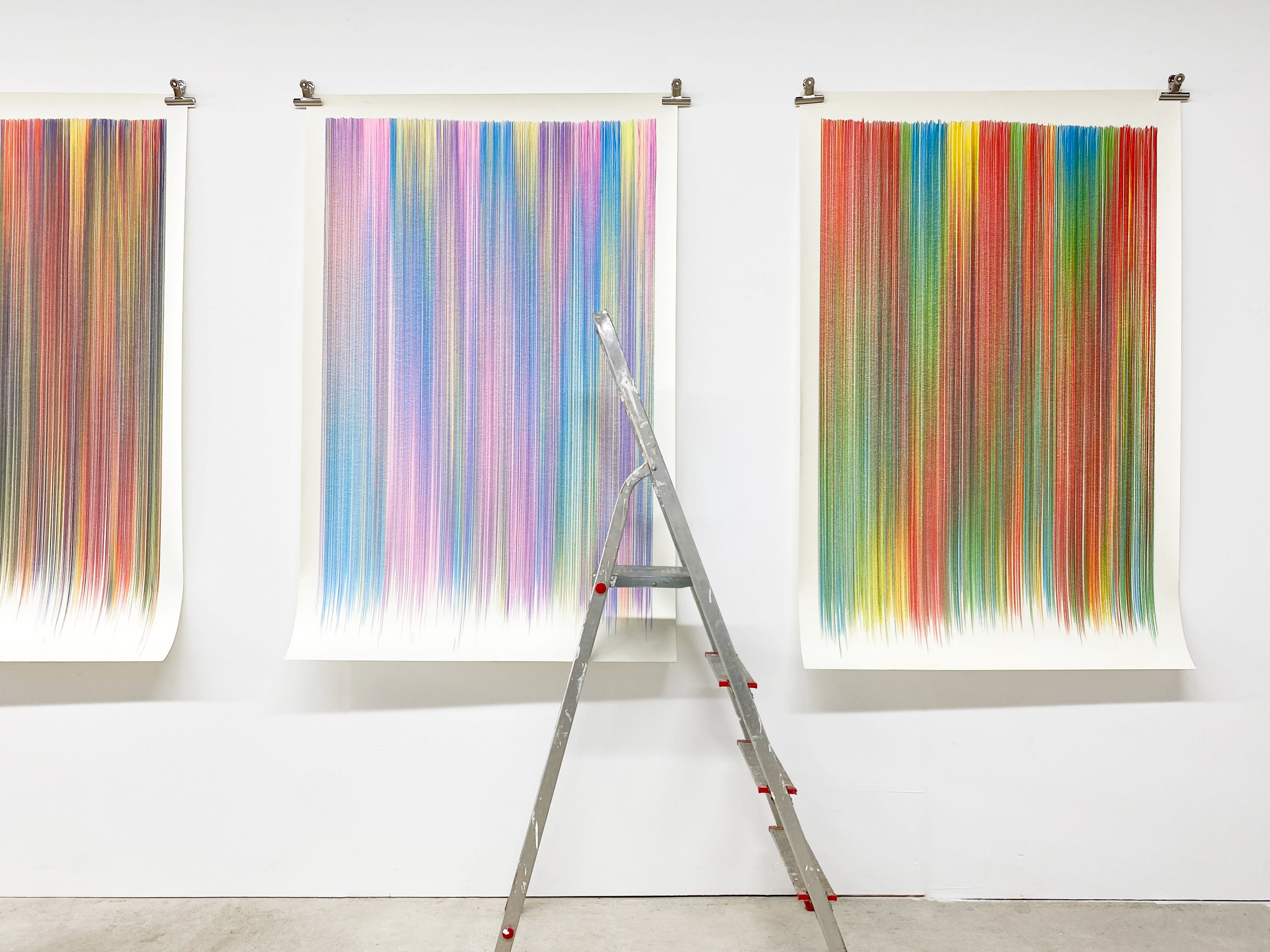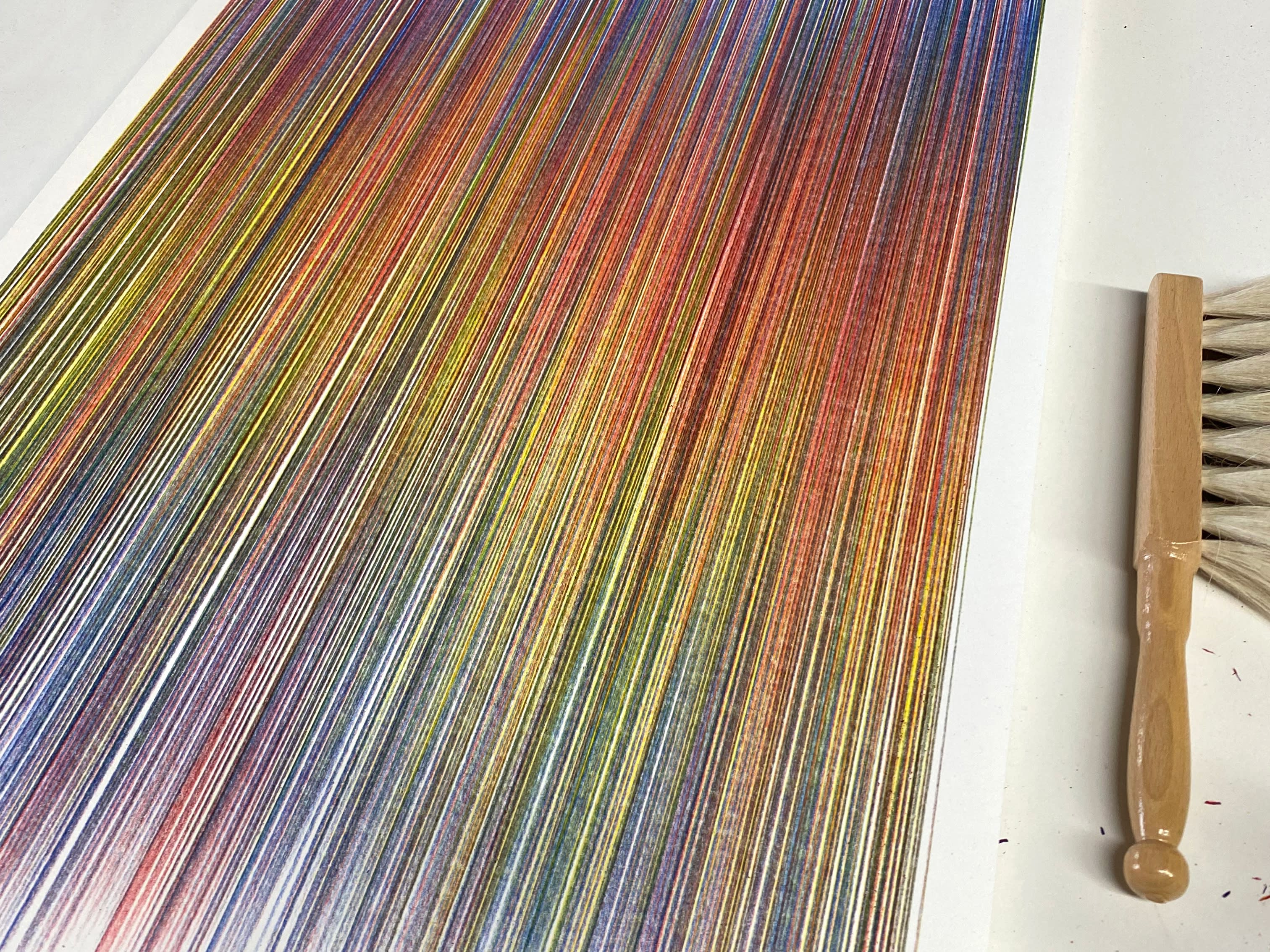
© Maria Seitz. Image: Ronja Paffrath, 2022
You have once described your art as “serial structures and repetitive processes forming the basis of drawings and spatial installations”. Tell me please, to what extent does it resonate with your inner self, with your character? Are you a structured and disciplined person or rather chaotic and spontaneous?
As a person I certainly rather identify with the description of structured and disciplined than with chaotic. For example, I like a certain clearness/basic order in my studio or certain routines/rhythms in working processes and also everyday life. So perhaps I can describe it as a kind of calmness I identify with which for me is basis/necessary for spontaneity, the chaotic parts, unexpected things or whatever may come up.
Observing your body of work and how it has been evolving in the past years, one cannot help but notice that you have chosen abstract form from the very beginning and remained faithful to it until today. Have you ever tried working in figurative art?
Yes, at the beginning of my studies at the art academy I actually still worked figuratively. At that time I was very interested in the subject of light and shadow. At first, I tried to depict spatial situations of incident light through windows in a painterly way. Then I switched to being interested in shadow outlines and shapes in drawing, which are created by such spatial constellations. Increasingly, however, it was no longer the shadow figures that interested me, but the abstracting, transforming of the process of depiction and drawing itself, as well as the spatial-installative potential of it.

© Maria Seitz's Studio. Image: Maria Seitz, VG Bild-Kunst Bonn, 2022
You definitely like colors, often mixing warm and cold colors together. However, sometimes you work monochromatically or decide for black-and-white. How do you make these decisions about color within your work?
The wide field of color I just discovered a few years from now in and for my artistic practice. Before that I worked mainly with one or two colors. For a long time, black and white represented a minimal binary color system for me, which I liked as a framing basis when I conceived new works. Underlying most of my works is a framing system within which certain phenomena between lines/color values are generated and explored through the drawing process. In the Multicolor drawings I work with multicolored leads. The starting point here is the decision of a certain type of pencil, which itself carries a certain combination of colors. The emphasis of the color spectrum and color play given by it is developed line by line, sheet by sheet – it is spread out over the drawing process into the paper surface. Within this process, a kind of exploratory curiosity plays a major role, since the concrete color gradient only becomes apparent in the drawing process through minimal decisions/turns of the pencil and thus reaction to the preceding line. With the Intercolor series, I first had to get used to choosing colors more ‚freely‘. Herefore I use monochrome pencils, so at the moment of color selection it is also the curiosity of which mixed color may arise between two concrete color values and what interaction then in turn comes up with the starting colors - because often this is beyond any rational imagination or predictability.
Your technique is truly unique, but it also requires a lot of patience, I guess. Do you consider the working process as a kind of meditation or what are you usually thinking of while painting the same line or pattern again and again?
The drawing process has definitely a meditative or contemplative aspect. A kind of flow of movement, of repetitive and serial rhythms, speeds, distances and sequences sets in while I’m drawing. This varies depending on the color, the time and the day - is sometimes more fluid, sometimes a bit bumpier. It is a kind of free space and state in which I can immerse physically and mentally – and which I really like. In the process, thought cycles often dissolve or are woven in. On the formal level it is at the same time a very exciting, concentrated process within the drawing, as nuances of color only become visible (are made visible) by continuously reacting to what happened before. Each gradient is unique and originates from this specific drawing time.

© Maria Seitz's Studio. Image: Maria Seitz, VG Bild-Kunst Bonn, 2022
Your latest work includes incredible window installations – how did you come up with the idea of using windows as a new medium? What was the source of your inspiration? And what message do these window installations transmit?
The window has interested me for a long time as an interface of interior and exterior space, as a membrane between private and public space, which also functions bilaterally and sets/generates sections of space and light - this led to different (installative) projects. At the same time, they often caught my attention as unused spaces that already exist in the cityscape in several types and dimensions, different kinds of grids and architectural contexts, and can thus become dispositifs for artistic interventions (as many cultural projects during corona lockdown made visible). Regarding the Multicolor Refill window installations, I am particularly concerned with trying to create a color site and color experience/moment in the urban space. Within the urban surrounding the installation can act like a colorful mark which can bring up new relations between drawing and the architecture of the building as well as the street context. The color structure somehow extends into public space in its direct or imagined effect. The installations of Multicolor Refill series often were shown by daylight and enlighted while nighttime, so the passersby can perceive varying color effects depending on the light situation.
Looking at your window installations, it becomes obvious that you enjoy exploring large-scale formats. At the same time, in your drawings you often go for smaller dimensions. What is more challenging for you?
Regarding the format sizes of my drawings, both the large format and the small format are exciting for me. Depending on the paper format there are completely different conditions that strongly influence the drawing movement and the color development. In the small formats, a dense concentration of movement, color and color phenomena takes place on a small surface through short movements of the hand, the pen and the color lines applied with it. The large formats are physically more challenging because the entire arm swings in wide movements, just as the color gradient stretches in length and develops more slowly. The large formats are insofar of course temporally and physically more enduring.

© Maria Seitz, Multicolor Refill, 2022. Image: Maria Seitz
Let’s talk about your upcoming project with Städtische Galerie Eichenmüllerhaus in Lemgo. What are the key topics you are going to address with the artworks featured at this show?
For the group exhibition at ‚Städtischen Galerie Eichemüllerhaus‘ I show works from the series 'Intercolor', which were created this year. There are small formats (42 x 42 cm) presented among large scale formats (145 x 145 cm). These colored pencil drawings are created by drawing two single color lines from opposite directions into/over each other. Between them, a third color surface emerges, a kind of 'mixed phase' or 'color horizon' that develops across the width of the paper sheet. For the exhibition, a selection was made from the series, which in sequence and arrangement attempts to establish color relationships, i.e. connections and breaks between individual color fields. The exhibition space on the upper floor of the house is very spacious and offers the opportunity to immerse oneself in this specific ‚color sound‘, which is favored by the light from the many windows and a slightly light grey wall.
You have recently made it through to the shortlist of Phönix 2022 Art Award for young artists. First of all, my congratulations with this big step, and second, could you please tell us a bit more about your entry – which works have been presented at the contest and what was the general concept of your entry?
Thank you! The application process for the Phoenix Art Award 2022 was a two-stage process. First, I compiled a comprehensive portfolio for it. In the second step, the finalists were asked to submit three originals. Here I decided to focus on one group of works in order to provide a clear, more deep insight compared to the first step. Therefore, I submitted three medium-format drawings from the Multicolor 5 series, which in combination opened up a spectrum of color variations and rhythms.

© Maria Seitz's Studio. Image: Maria Seitz, VG Bild-Kunst Bonn, 2022
You have already had numerous shows in Germany – Cologne, Düsseldorf, Berlin – just to name a few. To my knowledge you have also presented your works abroad, namely in New York. Would you like to develop in that direction, go global and enter the international art scene one day?
So far I have exhibited my work mainly within Germany. I was in New York once as part of a group project, which can be described as an interactive and installative community project - that was definitely very exciting. I would find it exciting to have future residencies or exhibition projects on an international level. Every location brings something new, new contexts and connections - both in terms of concrete, personal and mental/idea space.
And now let’s throw a glance at the future. How do you see your practice developing? What is the most extraordinary project you would like to bring to life one day, perhaps covering the windows of Kölner Dom with your Multicolor Refill series?
These kinds of questions are difficult to answer. So I would say: I see myself drawing on consequently and I see a lot of colour around. There is a lot to be discovered also concerning space and material. Regarding future installations I am interested in the diversity of spatial contexts. So I am just excited which places will follow, whether institutional or off-space, urban or landscape, here and there. The Multicolor Refill series for example started in the building of an empty gas station. It would be great to realize more really large-scale window installations in the future!

© Maria Seitz's Studio. Image: Maria Seitz, VG Bild-Kunst Bonn, 2022
Interview conducted by Valentina Plotnikova